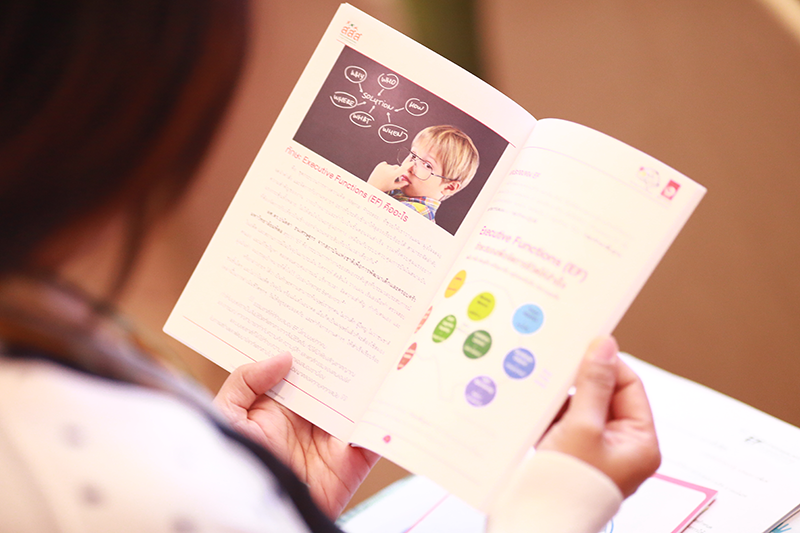eferences
Books ;
- Barkley, R. A. (2012). Executive Functions : What They Are, How they Work and Why They Evolved, New York, The Guildford Press
- Brodova, E., & Leong J.D., (2007), Tools of the Mind : The Vygotskian Approach to Early Childhood Education, New Jersey , Pearson Education.
- Caine, N.R., Caine, G., McClintic, C.,& Klimex, J.K., (2009), 12 Brain / Mind Learning Principles in Action : Developing Executive Functions of The Human Brain, CA., Corwin Press.
- Dawson, P., & Guare.,R.,(2009, Smart but Scattered : The Revolutionary “Executive Skills” Approach to Helping Kids Reach Their Potential, New York, The Guildford Press.
- Dawson, P., & Guare, R.,(2010), Executive Skills in Children and Adolescents : A Practical Guide to Assessment and Intervention, New York, The Guildford Press.
- Dawson, P., Guare, R., & Guare, C., (2013), Smart but Scattered Teens : The “Executive Skills” Program for Helping Teens Reach Their Potential, New York, The Guildford Press.
- Galinsky, E.,(2010), Mind in the Making : The Seven Essential Life Skills Every Child Needs, New York, HarpersCollins Publishers .
- Kahn, J.C., & Dietzel, L.,(2008), Late, Lost, and Unprepared : A Parents’ Guide to Helping Children with Executive Functioning. Woodbine House, MD p.17
- Kaufman, C.,(2010), Executive Functions in the Classroom, Baltimore, Paul H. Brookes.
- Meltzer, L., editor, (2007) Executive Function in Education : From Theory to Practice, New York, The Guildford Press.
- Mischel W.,(2014)The Marshmallow Test: Mastering Self-Control, Little, Brown
- Seana, M., Howard, G., Hill, Skill, and Will : Executive Function from a Multiple-Intelligences Perspective, in Meltzer L., editor, (2007) Executive Functions in Education :From Theory to Practice , The Guilford Press, N.Y.
- Vygotsky, L. S. (1986). Thought and language, A. Kozulin (Ed. & Trans.). Cambridge, MA: MIT Press.
Websites
- Trilling, B., Fadel, C.,(,21st Century Skills: Learning for Life in Our Times, Jossey -Bass, CA,U.S.A., http://www.p21.org
- Miller, E.K, Cohen, J.D., (2001) An integrative theory of prefrontal cortex function, Annual Review of Neuroscience Vol. 24: 167-202 www.ncbi.nlm.nih.gov
- Building the Brain’s “Air Traffic Control” System,
- Willis, J.,(2011 ), Three Brain-Based Teaching Strategies to Build Executive Function in Students, http://www.edutopia.org
- Rauner, M. D.,(Early Education Policy, http://catalyst-chicago.org
- Blair, C. (2002). School readiness: Integrating cognition and emotion in neurobiological conceptualization of child functioning at school entry. American Psychologist, 57(2), 111–127. https://steinhardt.nyu.edu
- Moffitt T.E., Arseneault L., Belsky D., et al. A gradient of childhood self-control predicts health, wealth, and public safety. P NatlAcadSci USA. 2011;108(7):2693–2698.
- Greenberg M.T., (2006),Promoting Resilience in Children and Youth : Preventive Interventions and Their Interface with Neuroscience, New York Academy of Sciences.
- Meltzer L., Krishnan K., (Innovative Strategy that May Enhance Learning for All Children , CEC Today,
- National Center for Learning Disabilities, Dec 2010, Executive Function Fact Sheet: http://www.ncld.org
- Self, D.W., Staley,
- Goldstein, R.Z., Volkow, N.D.. Dysfunction of the prefrontal cortex in addiction : Neuroimaging findings and clinical implications , Nat Rev Neurosci. 2011 Oct 20;12(11):652-69.
- Zamir,M., Robbins T.W., Fronto-striatal Circuits in Response-Inhibition: Relevance to Addiction, publish online www.sciencedirect.com
- Weintraub, S., et al (In Press). NIH, Toolbox for the Assessment of Behavioral and Neurological Function: Cognition domain instruments . Neurology. In “Building the Brain’s “Air Traffic Control” System, Executive Function Skills Build Throughout Childhood and Adolescence” ,
- Reynolds, A., Temple, J.,(2011) School-based Early Childhood Education and Age 28 Well-Being: Effects by Timing, Dosage, and Subgroups, Science. available at www.http://discover.umn.edu
- Heckman, J., Invest in Early Childhood Development: Reduce Deficits, Strengthen the Economy, http://heckmanequation.org
- Diamond, A., Barnett, W.S.,Thomas J., Munro S.,(Available at http://www.ncbi.nlm.nih.gov
- Enhancing and Practicing Executive Function Skills with Children from Infancy to Adolescence, http://developingchild.harvard.edu
- Barker, J.E., et al , Less-structured time in children’s daily lives predicts self-directed executive functioning. Frontiers in Psychology, 2014; 5 DOI: 10.3389/fpsyg.2014.00593,
- Kurth, S., Achermann, P.,Rusterholz, T., LeBourgeois, M., Development of Brain EEG Connectivity across Early Childhood: Does Sleep Play a Role? Brain Sciences, 2013; 3 (4): 1445 DOI: 10.3390,
- Bernier, A., Carlson, S.M., Bordeleau, S., Carrier, J.,Relations Between Physiological and Cognitive Regulatory Systems: Infant Sleep Regulation and Subsequent Executive Functioning. Child Development, 2010; 81 (6): 1739 DOI: www.ncbi.nlm.nih.gov
- Nixon, R., Brain Food: How to Eat Smart , January 07, 2009 http://www.livescience.com
- Davis, C.L., et al, Exercise Improves Executive Function and Achievement and Alters Brain Activation in Overweight Children: A Randomized Controlled Trial, Health Psychol. 2011 Jan; 30(1): 91–98.doi: 10.1037/a0021766, http://www.ncbi.nlm.nih.gov
- Godman, H., (2014),Regular exercise changes the brain to improve memory, thinking skills, Harvard Health Publications,
- Taylor, A.F., Kuo, F.E., Children with attention deficits concentrate better after walk in the park.The Journal of Attention Disorders ,
- Blair, C., Raver, C.C., Closing the Achievement Gap through Modification of Neurocognitive and Neuroendocrine Function: Results from a Cluster Randomized Controlled Trial of an Innovative Approach to the Education of Children in Kindergarten. PLoS ONE, 2014; 9 (11): e112393 DOI: journal.pone.0112393,
- Chase,R.F., Developing Your Children’s Organizational Skills & Executive Functioning,
- Reubke, P., More Time and Space for Free Play in Early Childhood Care, Symposium, VI/18 EECERA Annual Conference Strasbourg 2009, available at http://www.iaswece.org
- Bruce, T., (2001)Learning through Play: Buy Learning Through Play – Babies, Toddlers and the Foundation Years, London: Hodder and Stoughton (p.117)
- Vygotsky, L.S., (1967),Play and its role in the mental development of the Child, Soviet Psychology, 5,6-18,
- Elias, C. H., &Berk, L. E. (2002). Self-regulation in young children: Is there a role for sociodramatic play? Early Childhood Research Quarterly, 17, 216-238. ,
- Gmitrova, V., & Gmitrova, G. (2003). The impact of teacher-directed and child-directed pretend play on cognitive competence in kindergarten children. Early Childhood Education Journal, 30(4), 241-246.,
- Morales, J., Calvo, A., Bialystok, E., Working memory development in monolingual and bilingual children. Journal of Experimental Child Psychology, 2013; 114 (2): 187 DOI: 10.1016/j.jecp.2012.09. ,www.ncbi.nlm.nih.gov
- Carlson, S.M., Meltzoff, A.N., Bilingual experience and executive functioning in young children, Developmental Science 11:2 (2008), pp 282–298, ilabs.washington.edu/meltzoff/pdf/08Carlson_Meltzoff_Bilingualism.pdf
- Zuk,J., Benjamin, C., Kenyon, A.,Gaab, N. Behavioral and Neural Correlates of Executive Functioning in Musicians and Non-Musicians. PLoS ONE, 2014; 9 (6): e99868 DOI: 10.1371/journal.pone.0099868,
- Activities Guide Enhancing and Practicing Executive Function Skills with Children from Infancy to Adolescence , available athttp://developingchild.harvard.edu
- Guiney,H., Machado,L., “Benefits of Regular Aerobic Exercise for Executive Functioning in Healthy Populations, Psychonomic Bulletin & Review, February 2013, Volume 20, Issue 1, p 73-86,
- Activities Guide Enhancing and Practicing Executive Function Skills with Children from Infancy to Adolescence, available athttp://developingchild.harvard.edu






